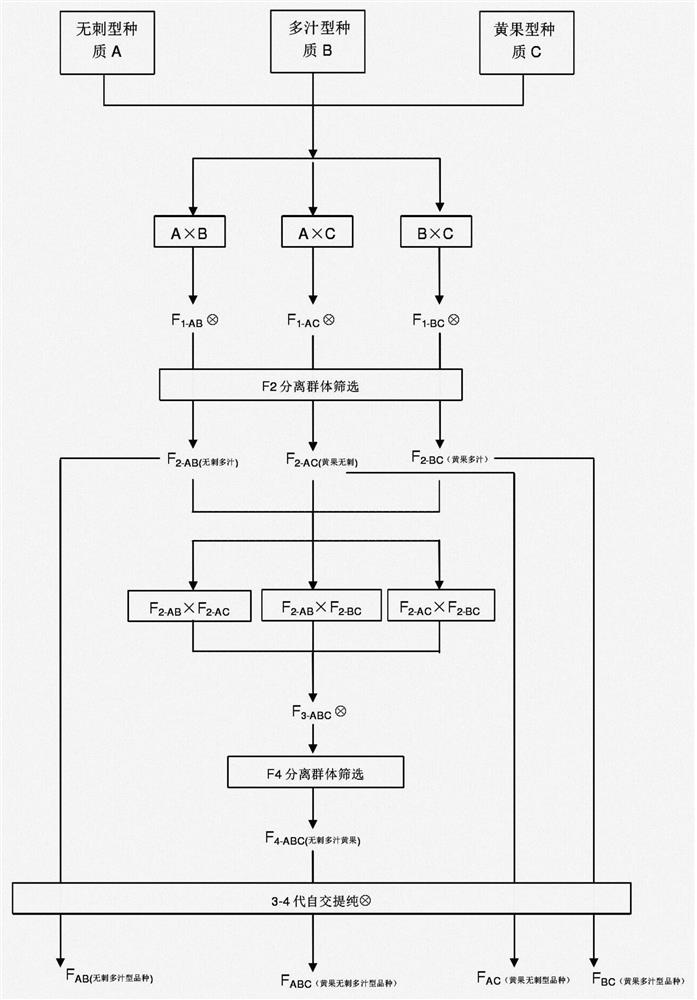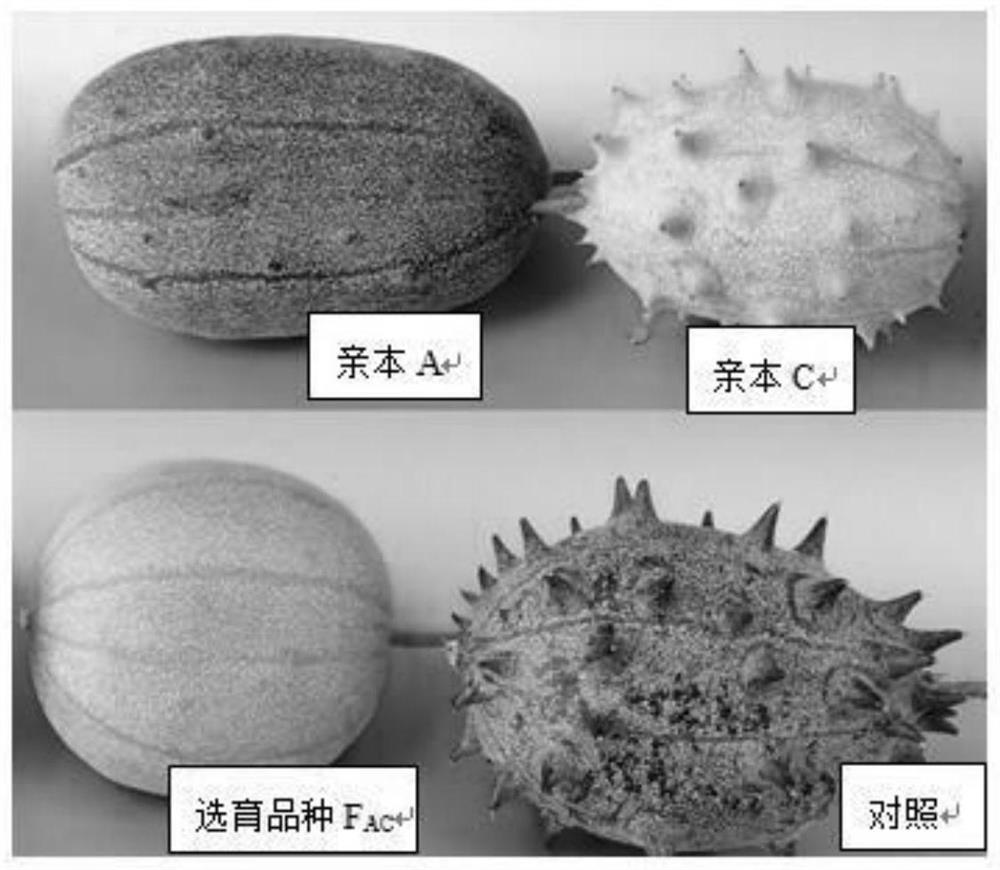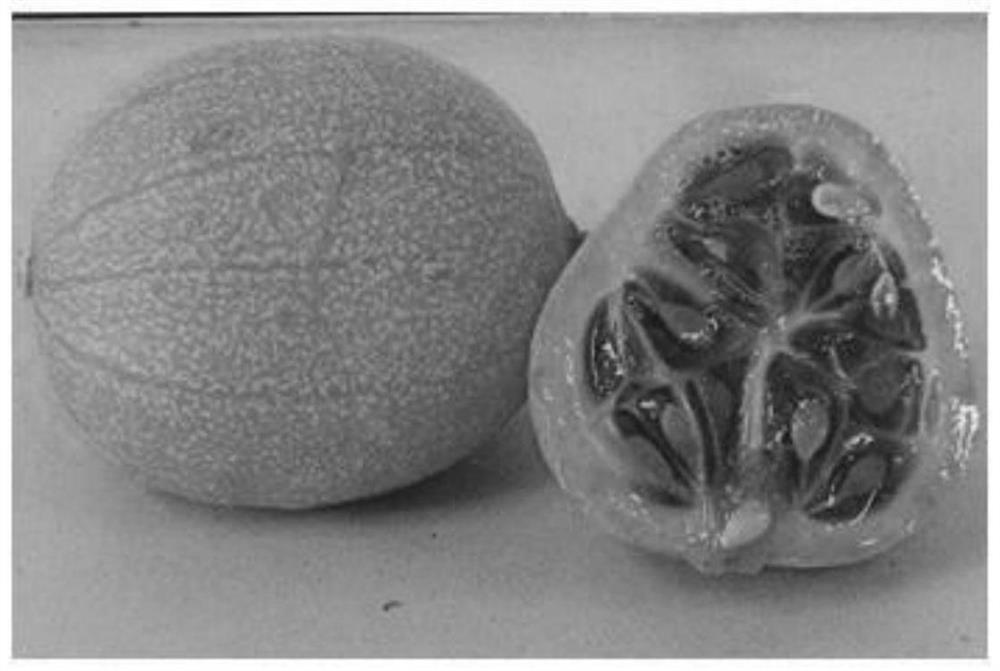Breeding method for different types of cucumis metuliferus varieties
A technology for fire ginseng fruit and varieties, which is applied to the field of breeding of different types of fire ginseng fruit varieties, can solve problems such as unfavorable development, fruit stabs on the fruit surface, lack of juicy varieties, etc. The effect of high cultivation value and application prospect
- Summary
- Abstract
- Description
- Claims
- Application Information
AI Technical Summary
Problems solved by technology
Method used
Image
Examples
Embodiment example 1
[0031] Implementation case 1: the selection and breeding of fire cucumber varieties with different fruit traits, including the following steps:
[0032](a) Screening of germplasm resources: In March 2015, the inventor planted 41 germplasm resources of fire cucumber collected and preserved for many years in the glass greenhouse of Zhengzhou Institute of Pomology, Chinese Academy of Agricultural Sciences (Zhengzhou), with a row spacing of 1.5m × a plant spacing of 0.4 m density colonization, hanging vine cultivation, single vine pruning, sowing 3 plants per germplasm, artificial self-pollination during flowering period. The investigation of the fruit expansion period includes fruit phenotype traits such as fruit thorns and peel color; the investigation of the pulp characteristics at the ripening stage of the fruit, and the investigation of the juice content through tasting methods. Among them, the plant with smooth and thornless female flower ovary is the thornless germplasm, wh...
Embodiment example 2
[0051] Implementation Case 2: In the spring of 2018, select the innovative F in Example 1 2-AB and F 2-BC , carry out F 2-AB ×F 2-BC Hybridization, has adopted the hybridization scheme of different route with step (4) among the embodiment 1, obtains the sub-table mark as F in hybrid offspring seed 2-ABC1 , F in fall 2018 2-ABC1 The seeds are sown, and the seeds are collected at the ripening stage of the fruit, which are marked as F 3-ABC1 , the spring of 2019 will be F 3-ABC1 Seeds are sown, and the succulent type germplasm of yellow fruit without thorns is selected in the offspring population, which are marked as F 4-ABC1 , Fall 2019, Spring and Fall 2020, Spring 2021 for F 4-ABC1 Four generations of continuous selfing were carried out, and a thornless yellow fruit juicy variety F with stable traits was bred. ABC1
Embodiment example 3
[0052] Implementation Case 3: In the spring of 2018, select the innovative F in Example 1 2-AC and F 2-BC , carry out F 2-BC ×F 2-AC Hybridization, adopted a hybridization scheme with a different route from step (4) in Example 1, and obtained the hybrid progeny seed marked as F 2-ABC2 , F in fall 2018 2-ABC2 The seeds are sown, and the seeds are collected at the ripening stage of the fruit, which are marked as F 3-ABC2 , will be F in the spring of 2019 3-ABC2 Seeds are sown, and the succulent type germplasm of yellow fruit without thorns is selected in the offspring population, which are marked as F 4-ABC2 , Fall 2019, Spring and Fall 2020, Spring 2021 for F 4-ABC2 Four generations of continuous self-crossing were carried out, and a new thornless yellow fruit juicy variety F was bred with stable traits. ABC2 .
[0053] In summary, the thornless and succulent variety F selected and bred by the present invention AB , thornless yellow fruit variety F AC , yellow fruit j...
PUM
 Login to View More
Login to View More Abstract
Description
Claims
Application Information
 Login to View More
Login to View More - R&D
- Intellectual Property
- Life Sciences
- Materials
- Tech Scout
- Unparalleled Data Quality
- Higher Quality Content
- 60% Fewer Hallucinations
Browse by: Latest US Patents, China's latest patents, Technical Efficacy Thesaurus, Application Domain, Technology Topic, Popular Technical Reports.
© 2025 PatSnap. All rights reserved.Legal|Privacy policy|Modern Slavery Act Transparency Statement|Sitemap|About US| Contact US: help@patsnap.com



